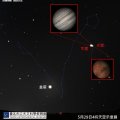
加拿大路易斯湖上空的火流星

Fireball over Lake Louise
Image Credit & Copyright: Hao Qin
Explanation: What makes a meteor a fireball? First of all, everyone agrees that a fireball is an exceptionally bright meteor. Past that, the International Astronomical Union defines a fireball as a meteor brighter than apparent magnitude -4, which corresponds (roughly) to being brighter than any planet — as well as bright enough to cast a human-noticeable shadow. Pictured, an astrophotographer taking a long-duration sky image captured by accident the brightest meteor he had ever seen. Clearly a fireball, the disintegrating space-rock created a trail so bright it turned night into day for about two seconds earlier this month. The fireball has been artificially dimmed in the featured image to bring up foreground Lake Louise in Alberta, Canada. Although fireballs are rare, many people have been lucky enough to see them. If you see a fireball, you can report it. If more than one person recorded an image, the fireball might be traceable back to the Solar System body from which it was ejected.
Tomorrow’s picture: big question
加拿大路易斯湖上空的火流星
影像提供与版权: Hao Qin
说明: 流星如何获得火流星的称号?首先,它要是超乎寻常明亮的流星。国际天文联盟则定义火流星为视亮度超过-4等的流星,大约比任何行星都要亮,而且亮到能投射出可分辨的人影。上图是一位天文摄影者在拍摄天空长曝光影像时,意外记录到他此生见过最明亮的流星。这颗崩解中的太空石块,很明显的是颗火流星,而且它极为明亮,在本月初它掠过长空的2秒期间,把黑夜变成白画。在这幅主题影像里,这颗火流星经过为人为减光,以利提高前景加拿大艾伯塔省路易斯湖的亮度。虽然火流星很罕见,但还是有不少幸运儿能亲眼目睹。如果你看到火流星,请回报。因为如有二人以上拍下影像,可据之反推是那个太阳系天体释出这颗火流星。
明日的图片: big question


